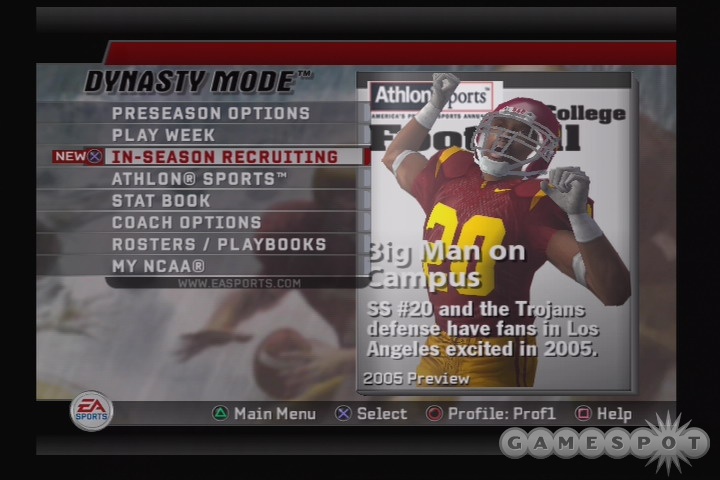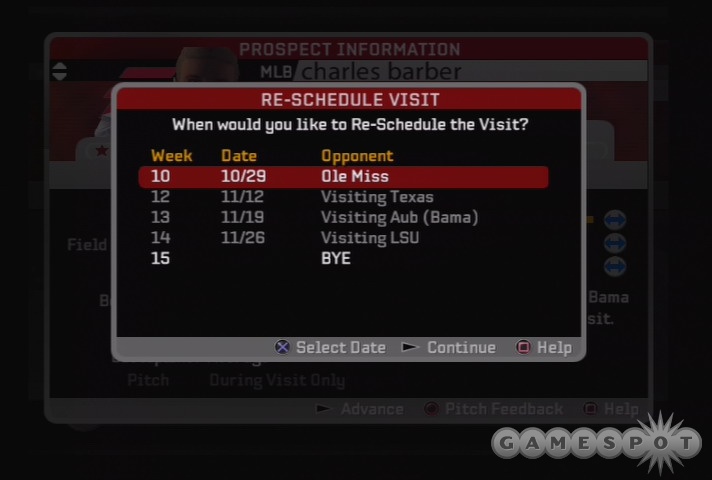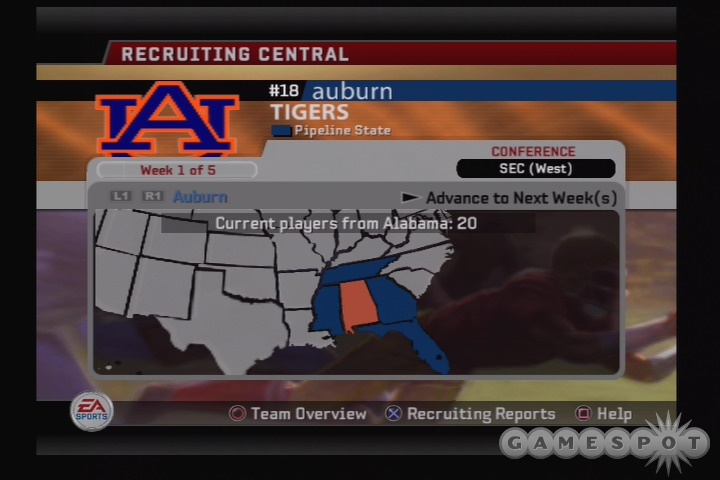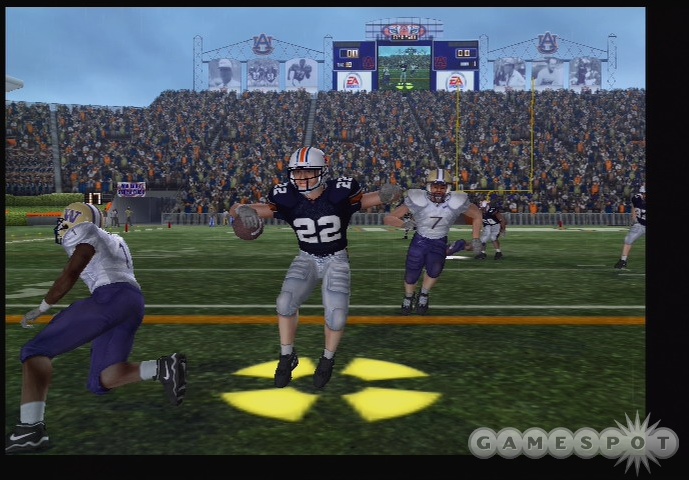NCAA Football 2006 Recruiting Spotlight
We go behind the lines with the coaching aspect of EA Sports' latest college football sim.
If you look at the schedules only, the college football regular season is only about three months long--from late August to mid-November. Of course, this segment is only the most visible part of the college football season. Ask a coach (or a truly hardcore fan), and he'll tell you that the college football season is "on" 365 days a year. He'll say it's a yearlong cycle that finds teams working just as hard in the offseason as they do during the fall, in preparation for Saturday games. It's nine months of study, preparation, observation, and decision making, followed by three months of letting it all hang out on the gridiron.
For the past several years, EA Sports' NCAA Football series has attempted to capture the intensity of the offseason in its dynasty mode by placing the gamer in the position of coach as you look to fill up your rosters for another fall campaign against your conference rivals. For some gamers, this game-within-the-game is just as compelling, if not more so, than the game on the field...especially as the interface and options have improved with each successive iteration. In this preview, we'll take a look at what's new for recruiting in NCAA Football 2006 to give you an idea of how you'll be spending your offseason time in the game.
Perhaps the most noticeable addition this time around is in-season recruiting. Convincing blue-chip talent to commit to your school is a year-round process, after all, and the competition is tough, and the stakes are high. And though you won't necessarily be the subject of intense media scrutiny or death threats from unhinged college football fans in NCAA Football 2006, you'll still have a drive to win. To do so, in-season recruiting will help you get a leg up on the competition by identifying holes in your lineup you'll need to fill once the next season rolls around. A handy screen gives you instant access to your team needs by position, along with the number of high school players targeted and their current commitments. You'll be spending a lot of time checking this screen as you try to make a determination of which holes need filling.

Once the season begins, you can allot recruiting points toward each of the prospects you have targeted. Each week you'll start with 100 points to distribute between your targeted prospects, and you'll be able to change the individual point allotments on a week-by-week basis. Indeed, if a player commits to another school, or signs a letter of intent to come to your school, for that matter, you'll be able to redistribute his recruitment points to other players. As the season progresses and your list of targets shrinks, you'll find yourself left with a handful of recruits, all of whom you can spend some heavy-duty recruiting points on to make the final push for a commitment.
Just as in real college ball, some aspects of any great football program include the atmosphere of the stadium, the energetic crowd, and the electricity of the game-day environment. Indeed, using games themselves as a primary recruiting tool is a time-honored tradition among college coaches. And you'll be doing the same thing in NCAA 2006. Later in the season, once you have a few interested candidates, you'll be able to invite them to campus for a game-day visit. There is some flexibility on scheduling visits, so you'll want to make sure your number one blue chip comes to campus during a critical conference matchup or during a crucial rivalry game. Just make sure you win the game, as your star player will be watching every move your team makes. When the recruit visits, you'll also be able to make a specific pitch on the merits of your program, be it the academic strength of the school, your coaching style, or a promise of early playing time. How well (or how poorly) the recruit reacts to that pitch will also have an effect on how eager he is to hitch his horse to your post or to some other school's post in the race.

One thing we noticed about the in-season recruiting in NCAA 2006 is that it seems to be much easier to pick up three- and four-star talent during the season, as opposed to during the offseason. Indeed, if you play as a lower-tier school, it may be your only source of blue-chip talent before the heavy-duty recruiting gears begin grinding.
Once the season ends, you should have a few recruits already under your belt. Now that you've whetted your appetite with the in-season recruiting, you can get down to the nuts and bolts of the dynasty mode's main course: offseason recruiting. Just as in last year's game, you'll start off with some budgetary matters by having to distribute your department's overall budget among three categories: recruitment, training, and discipline. As you might expect, the more budget money you grant one category, the more benefit you'll have in that particular phase of the offseason. More money in recruiting will mean more offseason recruiting points to use in enticing players, while a bigger slice of the budget pie in training will give you additional bonuses once drills begin.
In the Pipeline
While the majority of the recruiting process looks quite similar to last year, there is one key difference: the inclusion of pipeline states. In theory, pipeline states work in the game in much the same way they do in real life. As a result, the states closest to home are traditionally easier to recruit from than those all the way across the country...especially if your program lacks prestige. Schools like USC, Florida State, and Notre Dame won't have many problems recruiting talent from all over the nation, but for smaller schools, you'll need to correctly work the local angle to fill out your draft class from year to year. In one testing session, we started a dynasty with the University of New Hampshire Wildcats (a team we pulled into the Big East from the Division I-AA ranks), because we knew we would have zero pull outside our local pipeline states of Vermont, New York, Massachusetts, Delaware, New Jersey, and, of course, New Hampshire. It's important to note that as the seasons go on, your list of pipeline states will change, depending on your success on the field. For instance, in our second season with the Wildcats, New York, Vermont, and Delaware were dropped from our pipeline list in favor of Pennsylvania and Maryland.

As expected, once we checked the "interested prospects" list, it read like a who's who of fictional northern New England football. Well, that isn't exactly true. We had a few three- and four-star recruits looking to stay close to home, but for the most part, anyone who was interested in being a Wildcat for four years was of the one- or two-star talent caliber. You'll be able to sort through the list of high school seniors looking for a shot at I-A ball with a number of recruiting reports, which are organized by state prospects, the national top 100, all available prospects, interested prospects (a good place to start), and your returning players. Once you've selected players, you can return to your list with the handy "current targets" report also found in this menu, which will help you keep track of each player you recruit, his interest level, and his caliber. Players you picked up during in-season recruiting will also be shown here. As always, you'll be able to access a team overview screen that will give you a detailed breakdown of your team by position, rating, and class, as well as keep track of the number of players you have targeted, the number of players you have signed to commitments, and any team needs you currently have.
From here, the recruiting mechanics will feel very familiar to those accustomed to the series. If you're new to the game, however, the basics go like this: After targeting the players you want to go after (and have a reasonable chance of landing, based on their interest levels), it's up to you as coach to decide how to recruit them. The options you have here are numerous. You can choose to call the recruit or have an assistant coach do it; you can visit the recruit personally or send an assistant coach in your stead; or, for those players you really want, you can send everything you've got at them. Obviously, the more stridently you pursue the player, the more recruiting points it will cost you. Bear in mind that those points tend to run out quicker than you'd like, however.
To further assist you in your efforts, each player has a number of attributes, including field awareness, 40 time, vertical jump, and so on. Initially, these numbers are just best guesses. But if you're really interested in a player, you can choose to expend some points to find out exactly how much potential he has. In some cases, the numbers will improve; in many cases, they won't. You'll also get a "discipline" and "potential" rating for each player. All these numbers combined will give you a much clearer picture of whether this player is worth spending valuable recruiting points on.
As you move through the five-week recruiting process, you'll find out which recruiting pitches are working and which ones aren't through the same kind of pitch-feedback screens found in the in-season recruiting menus. Because you'll have several weeks to coax a recruit to your side, it's in your best interest to vary your pitches until you strike the right chord with your recruit. You'll be able to gauge the attention of your potential recruits through their interest meters, along with a handy arrow that will show you how each recruit's interest has changed since the previous week. We've seen some feedback strangeness in our preview build--recruits saying they want to go to a high-prestige program one week, then saying prestige doesn't matter in the next--but for the most part, by week four of the recruiting window, you'll have a pretty good idea of what kinds of pitches to use for maximum impact.

Once recruiting is over, you'll continue through the rest of your offseason duties, assigning players new positions (if you want), training, trimming your roster down, and, finally, setting the depth chart. Another new aspect of NCAA 2006 is the impact player. That is, a guy who can make a difference each time he takes the field or touches the ball. Impact players on your team will be in the depth chart, so you'll know exactly who needs to take the field on game day and who you can safely redshirt or bench. After that, it's back to the regular season to begin all over again. *Sigh* It's a beautiful thing, this cycle of college football, isn't it?
We may be a few months away from the beginning of a new real-life cycle of football, but the release of NCAA Football 2006 is just around the corner. Stay tuned for a full review of the game when it's released in early July.
Got a news tip or want to contact us directly? Email news@gamespot.com
Join the conversation